In his first major speech as Air Force Secretary, Troy Meink stressed that while the U.S. Air Force remains the most dominant in the world, sustaining that edge requires the most ambitious modernization campaign in its 80-year history.
The paradox lies in the fact that the current fighter-centric design pushes the service toward an unsustainable pace of growth and expansion.
Vulnerability of the Fighter-Centric Model
The present design relies on bases positioned close to adversaries — a strategy increasingly undermined by the proliferation of drones, missiles, and hybrid systems. Attacks in Russia, the Middle East, and Ukraine highlight how vulnerable air bases are.
Operating from farther away, however, drives the need for more costly tankers and fighters, while distributed operations shift the challenge from defense to logistics.
Rethinking Air Force Design
Rather than enlarging the current force or chasing elusive technological breakthroughs, the service must pivot back to operational innovation.
A new combined-arms approach, inspired by the U.S. Army’s Cold War-era adaptation to Soviet numerical superiority, could provide a sustainable solution. This model centers on three interdependent components:
- Edge Force – Small, mobile ground teams with one-way attack drones and surface-to-air missiles operating under the enemy’s defensive umbrella. Their role: deny, deceive, and disrupt.
- Pulse Force – Long-range bombers launching episodic, high-volume salvos from sanctuary, targeting naval escorts, air defenses, and key command nodes when the edge force creates openings.
- Core Force – Fighters, collaborative combat aircraft, tankers, and support assets that surge forward only after enemy defenses are degraded, establishing air superiority and sustaining operations.
End of “One-Size-Fits-All”
The post-Cold War Air Force thrived on broad superiority, making a single design viable everywhere. Today, with China’s military rise and the spread of precision strike systems, the U.S. needs specialized designs tailored to specific threats.
Shrinking the core force while bolstering edge and pulse forces would allow the service to counter challenges such as a Taiwan invasion.
Wargaming Evidence
Hudson Institute analysis suggests the combined-arms model could decisively blunt a Chinese assault. Under the current fighter-heavy approach, up to 60 percent of invasion forces might survive to land.
With the new design, edge forces and pulse strikes could annihilate the amphibious fleet, dramatically reducing both enemy survival rates and U.S. aircraft losses. This increases both deterrence and the willingness of U.S. leadership to intervene.
Overcoming Tradition
Skeptics argue that shrinking the fighter fleet and investing in ground-based missiles or drones runs counter to Air Force tradition. Yet Russia’s struggles in Ukraine show the risks of clinging to outdated models.
To avoid similar disruption, the Air Force must embrace innovation, even if it means redefining what airpower looks like in the 21st century.








